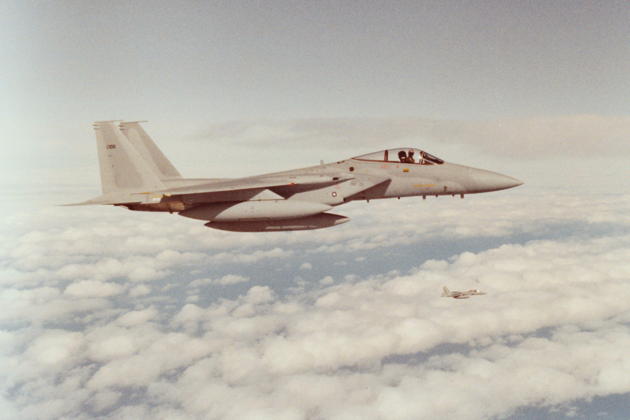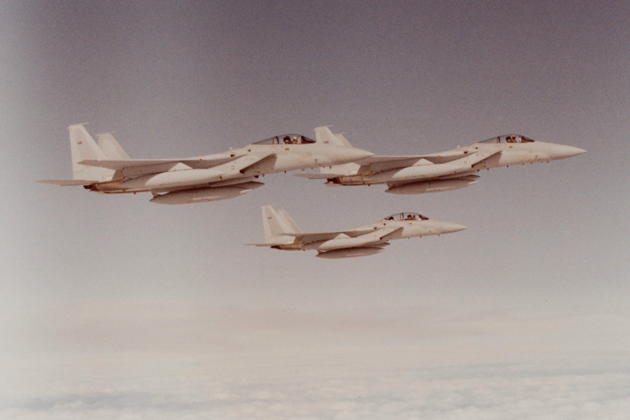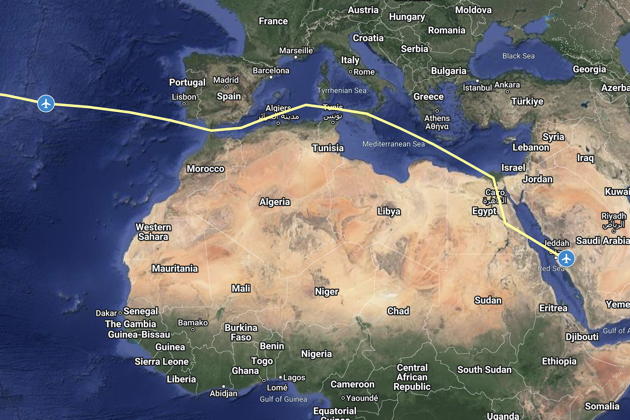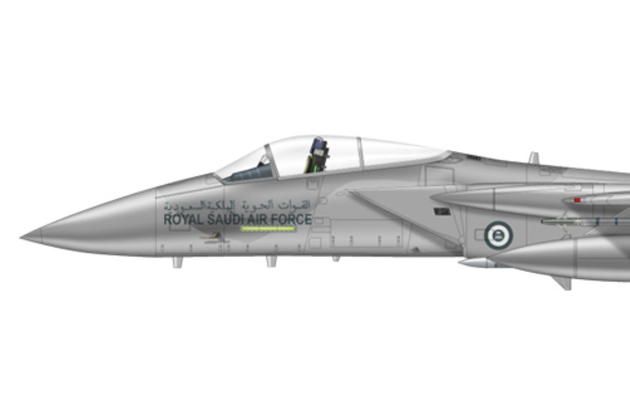FlightLog Archive
∟Aircraft Flown
A LONG cross-country - Mar 1983
After our very enjoyable cross-country in our Warrior from Renton, Washington to Rockland, Maine (and back) in 2022, I was reminiscing about other long cross-country flights during my flying career. The longest has to be a delivery flight of a brand new F-15C from the then McDonnell Douglas (now Boeing) factory in St. Louis to the King Fahad Air Base (ICAO code: OETF) in Taif, Saudi Arabia, covering 6737 nautical miles (NM), or 12476 kilometers (KM) in a single-seat fighter.
Most of my nearly 2000 hours flying the F-15 Eagle was enjoyed in flights heavily engaged in air combat training, averaging a very busy 1.3 hours per flight. Very infrequently I was able to scrounge a cross-country flight, either in Europe or the US. Long ocean crossing deployments were even more rare, but I'd accomplished flights from Langley AFB, VA to Soesterberg, Netherlands, three flights to and from Eglin AFB and European destinations, plus a long Nellis AFB, NV to Soesterberg excursion. Most long flights eastbound started in the early morning to provide for a day landing at our destination, and once the sun came up over Greenland, Iceland and the Canadian north, the scenery was quite impressive.
In 1982 and 1983, the Royal Saudi Air Force (RSAF) took delivery of 62 F-15C/Ds under the Peace Sun program, with delivery from the St. Louis factory provided by USAF F-15 pilots from either Langley AFB, VA or Eglin AFB, FL. Most delivery flights were conducted as three-ships, with the last few led by mostly staff officers, Lt Cols or senior majors. After one three-ship, led by a Lt Col, flew directly over Mecca and barely avoided an international incident, and a second three-ship, led by a senior major, almost ran out of gas en route to Taif, the Eglin and Langley Wing staffs decided to have subsequent flights led by active and experienced Captains.
I was requested to lead the next three-ship F-15 delivery, flying as Retro 31-33 with a Project number of Coronet East 79. The flight planning, tanker scheduling and diplomatic clearances were all coordinated by the 2nd Aircraft Delivery Group (ADG). Since we were headed for the cold North Atlantic on the first leg, we had to plan to wear water immersion suits, more commonly known as 'poopy suits'. Sitting in the hard ACES II ejection seats was the hardest part of other long flights, and I had tried cushions or rolled up G-suits, with little relief. On this flight, I obtained three hemorrhoid cushion donuts from the Eglin dispensary, and they worked extremely well, needing only a light inflation before takeoff, then expanding as we climbed to altitude. I briefed that if there was any chance of a planned ejection, we would need to be sure to remove the cushion beforehand.
My wingmen, Emil Lassen and Ken Burke, departed Eglin AFB with me on a quick Republic Airlines flight to Atlanta and on to St. Louis. We briefed with the local 2ADG representative, then McAir reps supported us as we checked out our three brand new Eagles. The new Eagles only had about 5 hours of flight time, flown earlier by McAir pilots for their required acceptance flights. Our birds all checked out perfectly during acceptance testing, and yes, they did smell like a brand new car, actually even better! On our planned departure day of 2 Mar 83, we awoke at 2:15AM, started our briefing, then found out our tankers had severe ice and weather problems at Loring AFB, Maine, so we aborted for the day.
While the detailed flight planning was accomplished by 2ADG using flight tracks and lessons learned from previous deployments, and we followed our tankers for a good portion of the flights, I had the responsibility of the flight from St. Louis until the first tanker rendezvous on the East coast with a tanker from Loring AFB, Maine. On the last leg, we would depart our tanker over the eastern Mediterranean near Egypt, and it would be my job to lead the flight across Egypt into Saudi Arabia, trying to avoid the communication issues, navigation problems around Mecca and low fuel issues that occurred on some of the previous deployments. Since no flight goes exactly as briefed, I reviewed the lessons learned from the previous deployments, and felt we could help our cause by flying higher across Egypt to reduce the fuel burn of the previous flights, and collected a bunch of alternate Saudi frequencies, beyond the 2ADG listing.
On 3 Mar 83, we awoke at 2:30AM, briefed with the possibility again of some Loring bad weather, but tookoff on-time at 5:27AM, using full afterburner from runway 12L at Lambert Field in a three-ship trail departure, giving a loud 'sound of freedom' good morning to St. Louis! We were smoothly cruising past Indianapolis when change #1 to our plan occurred. Air Traffic Control (ATC) announced that our tanker had cancelled at Loring AFB due to ice and crosswinds. My planned divert base was Langley AFB, VA, since they had F-15s based there, plus a 2ADG detachment, so we smoothly diverted to Langley to refuel and try for the Azores on the next day, logging 1.7 flight hours on 80-0100, traveling 693 NM, or 1283 KM.
After a 4:50AM wake-up on 4 Mar 83 and a steak breakfast at the in-flight kitchen, we briefed with the 2ADG rep and I led an on-time takeoff at 7:27 and proceeded to the northeast. This time, our KC-135 tanker made it airborne from Loring, and I had a great tanker rejoin, meeting him as planned just past Boston. We only needed one major refueling each, plus a quick top off as we crossed the mid-Atlantic toward the Azores. I generally had the three-ship in a wide tactical formation, but closed in tight for some air-to-air photos by the tanker crew. The overall weather was surprisingly good, and we were only IFR for about 20 minutes. Our inertial navigation system was better than the KC-135, but we stayed with them until they received a valid TACAN navigation lock from the Azores. I said thanks to our tanker crew and smoked inbound on our own for the last 200 miles, and led the formation to initial for a pitchout over the very picturesque Terceira Island, smoothly touching down on runway 33 after 5.3 flight hours at Lajes Air Base in the Azores, Portugal with three 'Code 1' F-15Cs, traveling 2313 NM, or 4283 KM. It was a rare day, flown exactly as briefed. Our last leg to Saudi Arabia would have a number of more typical challenges!
We had a planned rest day on 5 March, and toured the nearby town of Praia da Vitoria, checking out the squid and other delicious seafood and shops in town. We met our tanker crew, and I took them on a tour of our brand new Eagles. We briefed with the 2ADG rep for our planned very early departure the next day.
We awoke at 1:00AM on 6 Mar 83 for a steak and eggs breakfast, an update brief with 2 ADG and our tanker crews, who took off before us, since we climbed faster and would rejoin once the tanker leveled off. Here's where the first issue of the day appeared - I had a 'Left Inlet' warning light appear just after starting up. Normally I would abort the flight and let maintenance work the issue, but since there were no local F-15 experts in the middle of the Atlantic, and our tanker had already departed, I made a command decision to continue the flight. By placing the left inlet switch to EMERG, the inlet ramp would lock in the up position, and my only real limitation was to avoid supersonic flight and turns greater than 4Gs. I also decided to use afterburner only on the right engine for takeoff, to avoid any other left inlet issues.
Our three-ship departure at 3:45AM was therefore right on-time to rendezvous with our tanker east of the Azores. The very early start was necessitated by the goal to land at our final destination, or divert base, during daylight hours. The tanker was in and out of the weather at FL280 on our joinup, so I climbed our formation in the clear to FL340, keeping the airspace sanitized with our onboard radars. As we cruised in the pitch black night sky, still 1000 miles from Gibraltar, we had the most amazing views of the Milky Way and the brilliant star field. For a time, I turned the Head Up Display (HUD) intensity and cockpit lighting way down and it felt like I was suspended in space with my two wingman, very impressive. As we approached the gap near Gibraltar, with Spain on our left and Morocco on our right, we conducted an easy day air refueling to top off, and said thanks to our tanker as they departed on to Lakenheath AB, UK. I climbed our three-ship and cruised over the western Mediterranean, continuing north of Algeria for a smooth descent and rejoin with our second tanker of the day that had departed from Lakenheath. We topped off again over Sigonella AB in Sicily, then skirted by Libya, north of the Gulf of Sidra, wishing our guns weren't safed, remembering the F-14 shoot down of two Libyan SU-22 Fitters in Aug 1981, near the so-called 'Line of Death'.
While reviewing the fuel calculations from 2ADG, we caught a 1000LB math error, which was a contributing factor in recent fuel issues into Saudi Arabia. Also, in the early 80s, Egypt had no UHF air traffic control capability, so 2ADG coordinated ahead with Athens control for a transit altitude, usually at a non-efficient altitude in the mid-20s. I requested that our tanker hang as far into the eastern Med as possible to help with our fuel buffer. When our tanker split off back to Lakenheath, I requested FL410 from Athens control for our overflight of Egypt. They only allowed us to climb to FL370, but it was much more efficient than the previous mid-20s altitudes. Passing Cairo southbound, I understood the reason for the FL410 refusal, as we passed nose to nose with a 747 that was flying right at FL410. The views down the Nile highlighted the impressive green ribbon snaking through a sea of brown. Approaching the Red Sea, I has glad we were able to climb to FL370, as we passed over a massive dust storm that rose to over 25,000 feet. Trying early to make contact with Jeddah Approach Control, all our 2ADG frequencies went unanswered. The first alternate freq that I had researched before departing the Azores worked perfectly, however. Jeddah Approach came on frequency in a heavily accented voice saying "Standby", followed by a very crisp British-accented voice saying "Retro 31, radar contact, welcome to Saudi Arabia, proceed direct from present position to Taif". No Mecca issues for this flight!
As I began our descent, wind at Taif was reported as 350 degrees at 26 knots. I requested our planned runway 35, but was told "Sorry, that runway has been NOTAM'd closed for two weeks, cleared runway 25." Thanks for the NOT updated NOTAMS, 2ADG! Although we were requested to fly long straight in approaches by 2ADG, our fuel state was very good, and I wanted to get a good feel for the expected crosswind on landing, so I maneuvered our three-ship for a overhead flyby and sequential break. I pitched out with a 26-knot direct crosswind, landing in an impressive crab looking to the left of the HUD for landing. We delivered three brand new Eagles to the RSAF, with my left inlet the only squawk. We also asked them to check the tires after the heavy crosswind landing! We traveled 3731 NM, or 6910 KM in 8.1 hours. Our pre-planning and extra homework allowed for a busy but safe journey across the Mediterranean, Egypt and into Saudi Arabia.
Total flight time = 15.1 flight hours, quadrupling the total time on the jet!
Total distance = 6737 NM, 12476 KM
Epilog
The aircraft I ferried, F-15C 80-100, became RSAF 1313. After 23 years of operational service in the RSAF, 1313 crashed on 1 Nov 2006, 80 KM west of King Adbdel Aziz AB, in the eastern sector of Saudi Arabia. The pilot, Captain Abdullah Abuthnain, ejected safely.
 KASPRZYK
KASPRZYK



